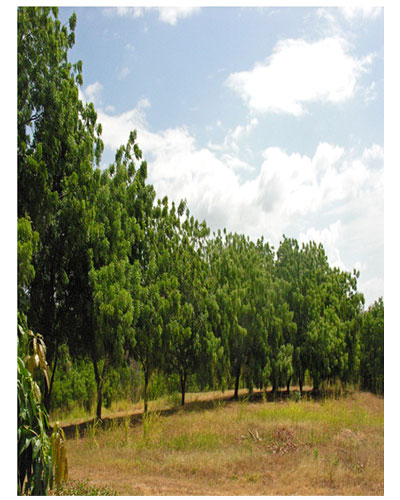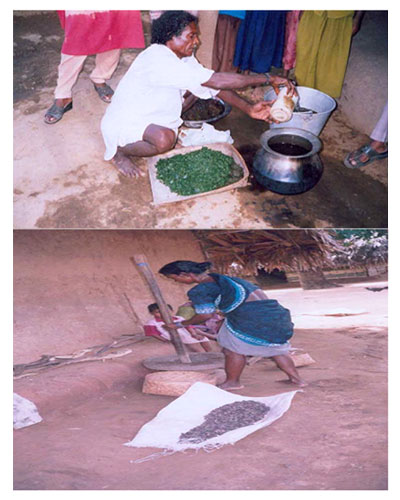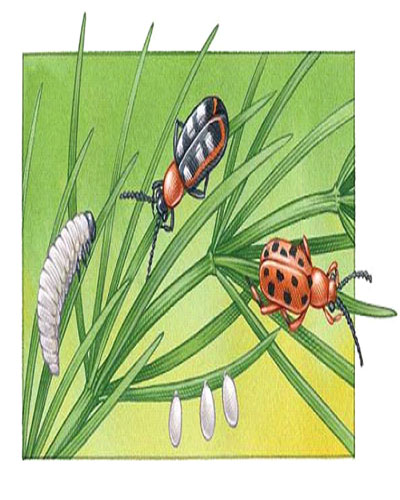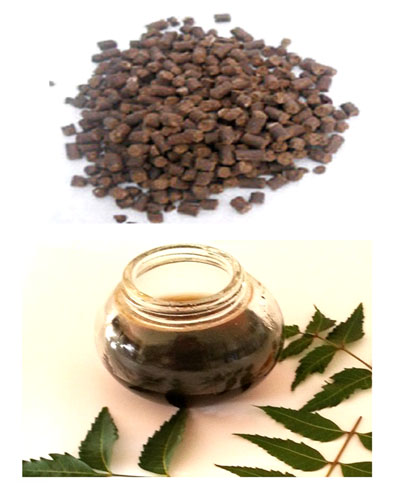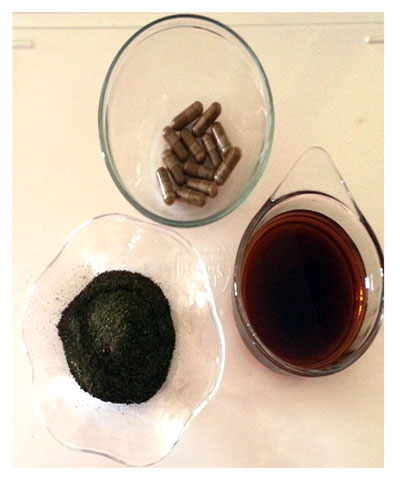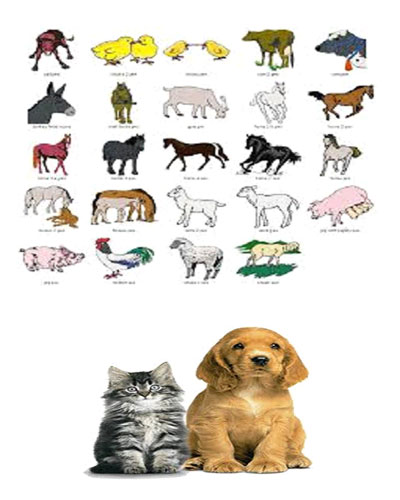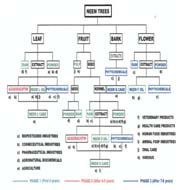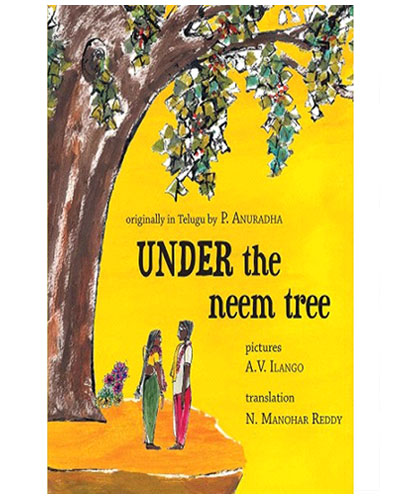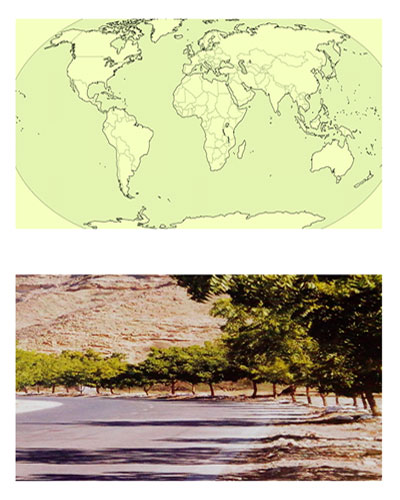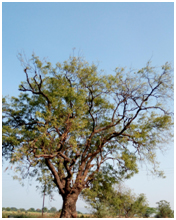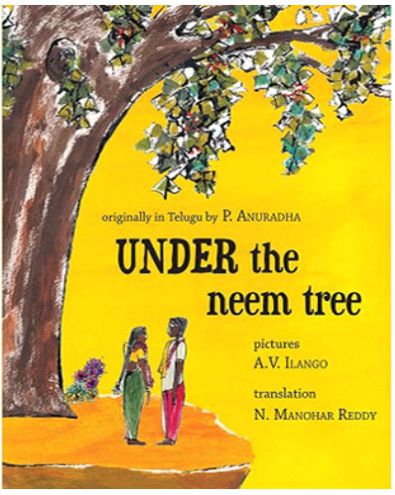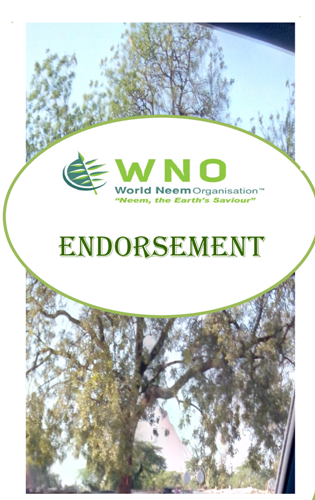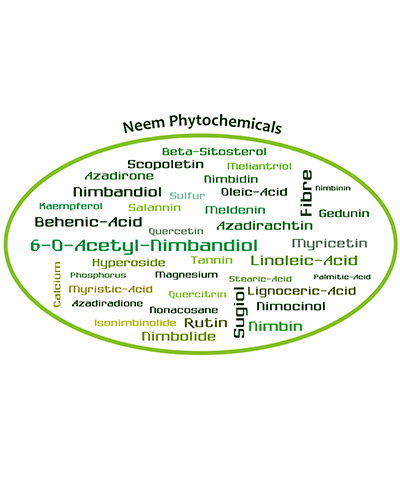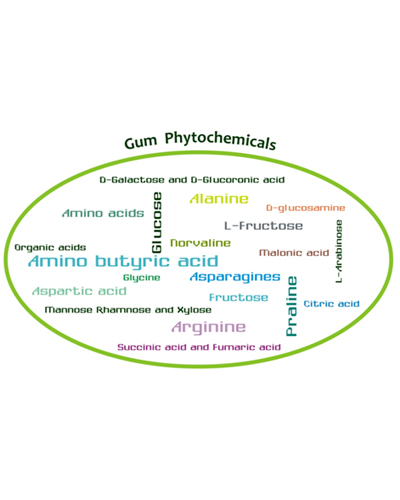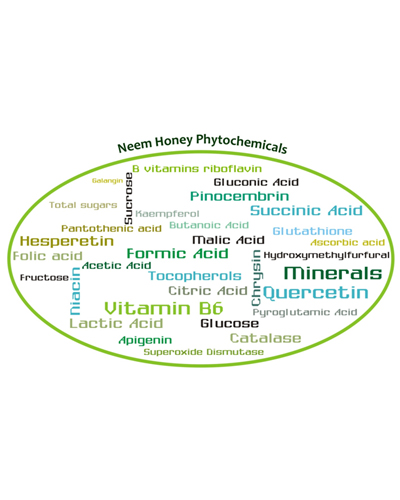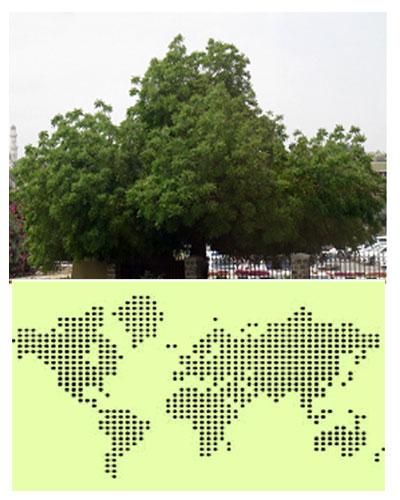Neem Story 1
My Mother’s Neem Tree
- Samanvitha Rao
It started with a tree.
When I was three years old my parents bought an 8000 sq. ft. plot of land in the coastal town of Surathkal in southern India and built a large home. Around the house they planted six coconut trees, three mango trees and several other tropical fruit trees including guava, chickoo, banana, jackfruit, and a large variety of flowers and decorative plants.
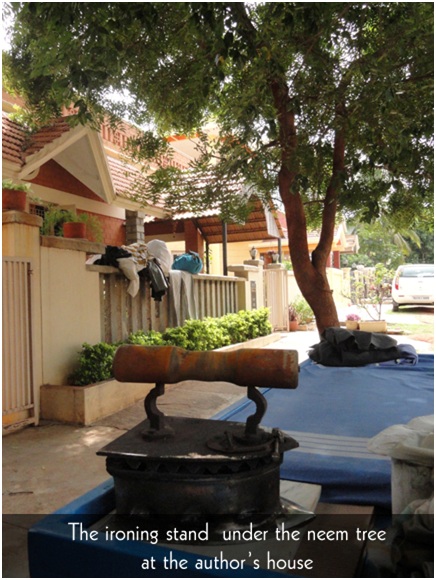
However, after retirement, the harsh summers and the relentless monsoon rains of the Arabian Sea coast drove them to my mother’s hometown of Mysore with its milder climate. There they procured a modest 2000 sq. ft. piece of land and built a manageable little abode. Downsizing and rightsizing was all fine and dandy, but my Mom sure missed her trees. Taking inspiration from a noted local environmentalist, Saalumarada Thimmakka, who planted and tended to over a hundred banyan trees along a stretch of highway, my mom decided to plant at least one tree in front of the house beside the street.
After weeding through a plethora of options, she settled on a Neem tree (Azadirachta indica). The very breeze that blows through a neem branch is supposed to have healthful properties. Eating fresh young neem leaves and flowers is said to keep diabetes at bay.
Water infused with neem leaves and neem leaf paste is supposed to cure many skin diseases. Beauty product aisles in Indian supermarkets are filled with neem face masks, neem shampoos, and the list goes on.
Not known for procrastinating, Mom went to a government nursery, brought home a neem sapling, planted it next to the gate, watered it, protected it from meandering cows, and gave it every love and attention. Soon her “neem baby” grew into a big tree. Its branches spread across the front yard and the shade provided cool relief in the master bedroom during afternoon naps. My mom’s joy and pride knew no bounds!
Soon Mom realized that she was not the only one enjoying the neem tree. One morning she peeked out of the window to notice that Dhobi (laundryman) Ramanna’s ironing cart was parked under the tree with hot coal burning red in his old fashioned iron-box. By the time she stepped out with her morning coffee, the entire compound wall was lined with colorful bundles of clothes waiting for their turn at wrinkle release.
“What is this Ramanna? Is there a clothes exhibition?” she shouted. “The shade is so nice ma’am; I’ll just finish ironing these clothes. Why don’t you give yours as well?” he replied, ever on the lookout for new business. “What do we do now about this new problem?” Mom complained to Dad, a little miffed at the turn of events. “Is it your street?” he questioned calmly without looking up from the newspaper.
Just like that a small mound of coal ash started to collect next to the gate. One day Dad had to leave in a hurry, and found that Ramanna had parked his cart blocking the gate and had inconveniently disappeared. Now what!?
“Leelu!” Dad called Mom. “You pull the cart aside, I’ll reverse the car,” he said. The street in front of the house is not exactly flat. Mom, in all her youthful 65-year-old glory was next seen pulling and pushing this heavy iron cart, sweat dripping from her forehead in the Indian summer heat.
Ramanna’s is a family business. At times his wife and seven-year-old daughter joined him beside his mobile ironing cart. His daughter delivered bundles of ironed clothes to homes along the street and collected money for her father. My mom, being the loving woman she is, used to give the girl some fruit, biscuits or other munchies. One day the girl came running to Mom crying “Aunty, I work so hard and collect all this money for my father, but he is refusing to buy me color pencils for Rs.10 (19 cents)”! And so Mom went as negotiator to Ramanna and they settled on splitting the cost down the middle. Little Chinty was full of smiles that day.
On another occasion Mom walked home with loaded grocery bags and there was Ramanna sitting on the front porch with a bundle of clothes. “Ma’am, the lady across the street is out. When she comes back can you please give her these clothes?” he pleaded. And so Mom spent the evening on the front room sofa with a bundle of colorful clothes, eyes peeled on the neighbour’s gate.
And then, almost inevitably, the lady down the street knocked on the door. “Aunty, I need to get these clothes ironed in a hurry, but the dhobi is not here yet. I need to go to the temple, can you please give him these clothes when he gets here?” she requested. “Of course!” said Mom and went back to chopping vegetables wondering aloud about when she had signed up to unofficially manage Ramanna’s dhobi business.
Lethargic after a sumptuous lunch, Mom was relaxing with a book in the front veranda one afternoon, when snap, snap, she heard breaking noises. Walking outside, she found a man on the Neem tree breaking small branches and twigs and hurtling it to the ground.
An unfamiliar rage colored Mom’s voice. “Hey you! Why are you breaking the branches?” she yelled.
“Oh be quiet Ma’am! They will grow back out! Kids in my village are down with chicken pox, so I am taking some leaves!” he replied. Mom watched him walk away with a third of her tree.
The plot of land across the street was sold to a new owner who started constructing his house. It did not take long for the construction workers to discover the neem tree and its cool shade. Soon the land around the tree became preferred parking for all their bicycles, motorcycles and cars. It also became the favourite lunch spot for all the workers. They gathered there every afternoon with their packed lunch. Stories of household sorrows and joys, mobile phone conversations, cricket commentary on the radio, minor rough-ups with loan sharks all broke the monotony in front of my parents’ house. On the day that sounds of “Kolaveri Kolaveri Di” disturbed the cherished afternoon nap in the cool shade of the neem tree in their bedroom, my parents decided to shift to the guest bedroom at the back of the house.
One morning at about 11:00 a.m. Mom heard some loud altercations. Cautiously she peered out from behind the curtain to find several “muscle men” standing under the neem tree, smoking cigarettes! Mom quietly stole to the backyard to ask the maid what was going on. “There is some dispute regarding the road due to the new house construction, so these are local hooligans from the village. You stay indoors!” she advised.
The next day Mom walked out hearing sirens to see a police jeep parked under the tree! Yesterday it was hooligans, today its law enforcement, she sighed. And all day she got inquiries from neighbours about why the police had visited her house!
Soon the local college boys discovered the neem tree. Very soon there were throngs of boys on their motor bikes hanging out in the evenings under the tree, smoking cigarettes and gossiping about cricket, professors and, of course, girls, who joined in every now and then. News of the new young world wafted into my parents’ living room in the evenings providing ample entertainment.
This was just as well, since moving all the vehicles blocking the gate to take the car out and go for an evening drive was becoming more and more tiresome. My parents had to solicit passers-by to help move vehicles when they needed to take the car out.
Just as Mom was starting to pull out her hair over the tree, my aunt visiting from Chennai dropped a conversational bomb about the root damage neem trees could cause to the building structure and the amount of money needed to fix it. For the first time the thought of chopping the tree down entered my mom’s mind.
One day Mom was sitting in the front porch reading a book and slowly she looked up at the tree. It was spring and the tree was full of fragrant blossoms. She took a deep breath and relaxed, enjoying its shade, beauty and fragrance. The branches swayed to a gentle breeze and seemed to smilingly say “I am the one providing the shade and I don’t mind all the drama. Why are you worrying?” And just like that Mom realized her “neem baby” was all grown up now. It was alive, it was well, and it was fulfilling its promise in the world.
Samanvitha Rao is a Technical Marketing Engineer based in San Jose. She is an avid adventure enthusiast. This article was inspired by her mother, Leelavathi Rao’s story, published in the Kannada magazine Sudha.
..........................................................................................
Neem Story 2
Inspirational Story Of A Boy And Neem Tree: Nimai Forever
-
Shyamal was looking affectionately at Nimai from his bed. He had been in bed with typhoid for a month and Nimai had been his best companion all the time. He could hardly think of a more enchanting scene than handsome and elegant Nimai standing erect, holding his head high against the background of the shining blue sky. He could almost hear his grandfather’s voice in the murmur of the small green leaves and the long, spreading branches of Nimai, telling how Hindus believe that a few drops of heavenly nectar fell on the neem tree, and that is why it makes people free from diseases.
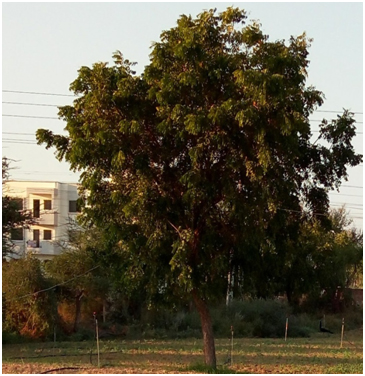
After retiring as the Director of a multinational company, he found the greatest pleasure of life in reading books on India’s culture, literature, and mostly India’s vast wealth of trees and plants, and nobody could stop him when the subject was neem tree. He could talk endlessly on the applications of each and every part of the tree in Indian Medicine. The seed oil and soap made there from can be used very effectively in various skin diseases like indolent ulcers, ringworms, and in rheumatism. The bark is used as tincture. People say it is beneficial in malaria as well. Grandpa always used the fresh tender twigs to clean his teeth, and the children of the house learnt to do so. Grandma and mother always kept dried neem leaves in books, paper and clothes to protect them. ‘Neem-begun’, or leaves of neem fried with small pieces of brinjal, was a favourite dish of the whole family which was eaten as prevention for pox.
In his childhood, once grandpa had smallpox and his mother used to comfort the burning with neem leaves. He often told Shyamal, his most obedient listener, that the neem leaves still reminded him of his mother’s affectionate touch.
The tree shade was the place where the old man enjoyed happiness and bore sorrows. When the grandsons and daughters were born, their naming (‘namakaranam’) ceremonies and all birthday parties were celebrated here. His love for nature was reflected in the names of grandchildren Banani, Banashree, and Shyamal.
When uncles were married, the new brides were welcomed under the tree.
On Diwali, the first lamp had always been lit there.
Shyamal remembered the day forever when the news came that his grandma had died for heart attack at his uncle’s place, Mysore. The old man didn’t utter a word, but resorted to his Nimai. He sat there the whole day like a statue, perhaps trying to get the strength to beat the heart-breaking loss from his age-old companion, while the other had departed forever.
And his end also came so suddenly and silently. He was sitting outside even after it was dark and Shyamal’s mother sent him to call grandpa. At first Shyamal thought that grandpa was dozing and he tried to wake him up. “Grandpa, your time of chatting with Nimai is up.” His head bent down on the chest by Shyamal’s touch, and suddenly the child realized that the time has been over indeed, while one or two leaves were still falling in the old man’s lap.
So far, Shyamal was completely lost in his thoughts, looking at the slim and shiny leaves, which had been always his favourite pastime. He was a sentimental and thoughtful boy, very much after his grandfather, but his materialistic engineer father never liked this.
..........................................................................................
Neem Story 3
A STORY OF A WALKING STICK
- ENGLISH SHORT STORY PUBLISHED ON NOVEMBER 26, 2014 BY JAYANTI SHINGE
This is the story of man's cruelty. The painful yet beautiful story of the journey of a walking stick. It takes us through its beautiful life and introduces us to the world of trees
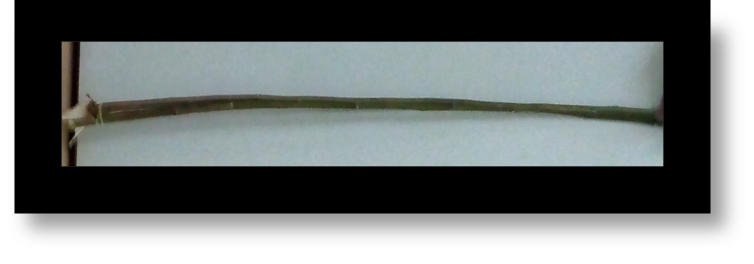
I help old people to walk. I am the one who support them while walking. It gives me lot of happiness. Can you guess who I am? Yes, you are correct I am a Walking Stick. I am the need of all old people who cannot manage themselves on their legs without help. I give them support so that they can walk with their heads held high.
The story of my birth goes seventy years back. I still remember I was a beautiful Neem Tree. There were many different kinds of trees around me. I had a lot of friends. We used to talk with each other. The chirping birds were our inhabitants. They had many nests on our branches. And early in the morning we used to get up by their melodious chirping. It was really very beautiful to see the small ones learn the flying lessons. I still remember those days. My friends used to say that I was the most beautiful and mighty tree in the vicinity. They loved and revered me. And I loved them too. I had a very huge canopy of branches. I was a kind of village in itself. Travellers used to rest under my shade. They used to choose me as I was very thick and sun rays could not easily pass through my canopy. I felt very humbled and special when the travellers or the birds or the animals came under my care. My heart use to swell with pride. The travellers used to get relieved with the cool breeze that I used to fan them. They used to relax themselves, eat their food, drank water and then again start their journey. It was such a pleasure.
Things have changed now. Man has become materialistic. People don’t walk places anymore. People in my time used to walk to different villages. It used to take them three to four days if the village is far. But things have changed drastically now. Everything has got wheels. Life has become more precise, practical, fast and luxurious. The number of birds has reduced and also the animals. Man has encroached everywhere; he has even snatched the habitat of these precious animals and trees. He is cutting trees for his own benefit. My brothers and sisters are being cut everyday for their tall buildings, malls and complexes. Man has been a very selfish creature. He does not think about anything except himself and his happiness. One day they will have to repay with the harm they have done to us.
I am a Neem Tree; every part of mine is very helpful to man. I inhale carbon dioxide in the morning and give out oxygen and in the night the procedure is reverse. My leaves and trunk are highly useful for medicinal purpose. Though I served man with every part of mine, one fine day I was killed. I was cut with a machine as they wanted to clear the path for building a flyover. It was very painful to see my sons and daughters my branches being cut in front of me and I could not do anything but just cry loudly. I was separated from my wife my roots. She was the foundation of my life. She gave her entire life nursing and feeding and taking care of us. She saved me and children from floods and storms she held us tight and united with the soil and thus helped us flourish for seventy years. I was so huge that they had to cut me into many pieces to carry me from my birthplace. The nests fell down and the unborn birds died before they could fly in the open air. Their parents cried with horror but could not do anything but just cry their hearts out. Every small insect which lived on my huge trunk got crushed. A rare kind of machine called a crane lifted my parts to drive me to a timber yard.
I was lying in parts; they had to make four trips to shift me completely to the timber yard. I was very angry with “MAN”. I hated him. But a voice, a rare one a very beautiful voice reached my ears. And it was God, he said, “Son! Don’t cry, you have served me well these many years, and I am very happy with your services you delivered to mankind. You have lived your life well and enjoyed it too. You still have many things to accomplish. Don’t cry as you were born to deliver. You were born to deliver your love and affection to my people. I know mankind has become selfish but one fine day I will make them realize what they have lost. I have chosen you, your wife and your sons and daughters for a unique job. I want you to be a helping hand to the old people. Many of them cannot walk. And their children have no time for them. I want you to become their support. Become their hope, their strength, their desire and a friend. You help them rise in their ripened age. Make them happy. Help them smiling when they have lost everything.”
I listened to God with my family and felt that we are privileged to have been chosen by God for a wonderful job. My leaves and the skin of my trunk and branches were peeled off and were sent to the factories which needed them. And then I was cut into thin and thick planks and then sent to factory which made walking sticks. They could make around three hundred sticks from me and my family. With the left out wood beautiful toys for kids were also made. I was polished with beautiful hue. And my family members too were looking very charming dipped in beautiful and vibrant colors.
When I was dry and ready to be packed, all the three hundred sticks were packed and sent a very big mall. There was a particular shop in the mall called, “Woody! Woody!” This shop housed all the crafts made out of wood. I met many old friends of mine in the shop. It was long time they were separated from me. Some of them were beautiful couches, some cupboards, some pots and some toys. They were delighted to see us after many days. I was very beautifully laid on the racks of the shop. I was shelved in such a way that I could easily be seen by the customers. Their hung a tag on my neck. My neck was decorated with a golden lining. I was looking very handsome and beautiful.
It was on the third day that an old man walked in our shop. He had seen me from outside, that is through the window. He was accompanied by his granddaughter a very cute little chubby girl. I knew he liked me and I am going to be picked by him. He came straight to me and bought me off though before buying me he tried to walk using me in the shop to check if I was fine for him. He finally paid the amount and took to my new abode. I was happy as well as sad. I was happy as I would be going to a new place to deliver my services to an old man. And thus I would be listening to God and make him proud and on the other hand I was very sad thinking of my family and my friends. I blew kisses to my family and friends and started my job. I have been rendering services to my master. His name is, Mr. John Steve. He is 75. He loves me as he carries me everywhere. Both of us go walking and spend a lot of time together. I love my job as I bring relief and happiness to this man. When I go for walking I meet my friends and family members who stay in the neighbourhood. Life is beautiful……especially when we help the needy, and bring happiness and smiles to other faces. Thank you God! For helping me identify myself…A WALKING STICK…
--Jayanti Dattatreya Shinge
..........................................................................................
Neem Story 4
Ghana’s Success Story- A Backyard Neem Tree Inspires New Pharmaceuticals
Since graduating from university in 1984, Isaac Bohulu had been a pharmacist in Accra, Ghana including six years spent at Hoffmann-La Roche, the Swiss-based international pharmaceutical company. But he always was an entrepreneur at heart, especially after gaining his Masters’ Degree in Business Administration (MBA) with a marketing focus.
Believe Begin Become Business Plan Competition Kick-starts Natural Scientific Pharmaceuticals Company
In 2006 he learned about Techno Serve’s Believe Begin Become (BBB) Business Plan Competition in Ghana. He had already planned to start his own natural medicine business so his goals then became to win some money to jump start the new idea as well as receive some practical training. Isaac was a top 20 finalist, receiving $15,000 cash and $10,000 in services to start testing Neemfresh, an herbal mouthwash using extracts of leaves (and other parts) from a large Neem tree in his backyard!
Though most of the [Believe Begin Become] training theories were not new to me,” Isaac states, “now I am implementing better business practices, such as separately tracking business vs. personal expenses. Besides the prizes, there were many other useful aspects: learning the importance of networking; maintaining key relationships; exchanging new ideas; exposure to different expertise; and problem solving. I especially enjoyed mentoring “young ones” with less experience. Techno Serve and my BBB colleagues are resources when I need help; they have opened doors and linkages to new funding and other resources.” As sounding boards, linkages to new clients and area-expertise among other things, members of Isaac’s peer network— thanks to Techno Serve–have had been his best counsellors.
In 2007 Isaac obtained a business license to build a lab/manufacturing space in a separated bedroom of his house. Most of the BBB cash prize went toward processing equipment (e.g., water pumps, filtration system, and refrigeration); bottles for the products; and his lab/manufacturing addition. His services money paid for a media company to create product ads. He has been very busy honing the formula with feedback from his pilot customers to successfully apply to Ghana’s food and drug board for certification of Neemfresh mouthwash.
As of February 2009, Isaac still ensures his family income and cash flow for Natural Scientific Pharmaceuticals by working weekdays for a private insurance company, then weekends and evenings on his herbal products. With the help of three sales reps, a factory worker, and his own marketing knowledge, he has focused on recruiting Neemfresh customers from dental-related groups. For example he has done a presentation to the Accra Dental Association so now some private dental clinics are using his product and the local dental school and a nearby hospital are interested in trials. Also, he is advertising on targeted-demographic radio (e.g., with professional and trendy young listeners who care about their appearance), and promoting Neemfresh’s competitive advantage of ensuring both healthy gums and teeth.
Diverse Nature-Inspired Products
Natural Scientific Pharmaceuticals offers discerning customers high quality, herb-and-plant-derived choices rather than industrial-chemical-based products. As Isaac’s company expands sales and facilities to reach his 5-year goal, he could require as many as 20 employees for running the factory floor, administration and sales. Certainly as a growing small business, his new staff, suppliers, revenues and taxes will impact local, regional and national economies. All these factors are positive for Ghana’s medical health and communities’ welfare.
Mentoring Key to His Success
Naturally realistic yet optimistic, Isaac has been laying the foundation for his company’s long-term success. He’s begun to pilot test more herbal products such as a nasal spray decongestant for ongoing sinusitis and a body cream using shea butter and herbs. All his products are sold directly, through word of mouth and targeting key customer environments like dental clinics. With support from his BBB alumni network, he has set pragmatic business goals for Natural Scientific Pharmaceuticals for the next year and several years out by which time he plans to more than double revenues. In order to make a profit with strong inventory turnover, Isaac’s top priorities are to enforce Accounts Receivable for goods already sold; establish bigger manufacturing and warehouse space; create and implement the right strategy to develop and commercially launch multiple health-care products; and leverage venture capital money to sustain operations and buy additional equipment. Thanks to Isaac’s BBB colleagues, he knows “I now pick up the phone to ask for help. I’ve learned never to ‘go it alone’.”
--
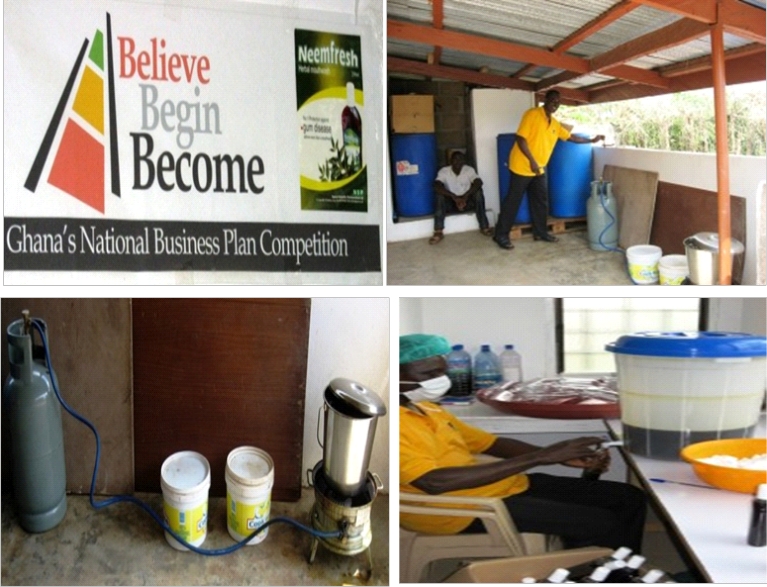
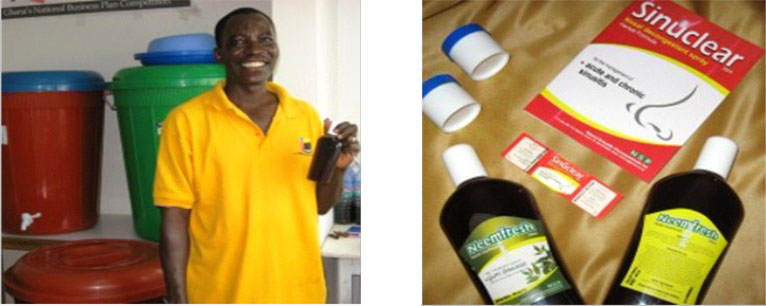
..........................................................................................
Neem Story 5
Forestation Projects & Neem Tree Planting

Altos de los Mores, because of its location in northern Peru, is a coastal desert! There are not many trees, there are virtually no government sponsored tree initiatives, and the place is hot, barren, and full of sand. Walking through this area on a typical day is tortuous, due to the extreme heat and sun. This area is in desperate need of trees, but again, not too many trees can thrive in these conditions.
One tree that was introduced to Piura, Peru in the last 20 years is the “Neem Tree.” The Neem tree was brought to a university in Peru, from India. It has been used in India for centuries and is known as “the pharmacy of the poor,” because it offers over 150 medicinal remedies ranging from malaria, colds & fevers, to diabetes. It is anti-bacterial, anti-inflammatory, and dermatological. Apart from these amazing benefits, the tree itself can withstand harsh desert conditions, grows incredibly fast, and big, providing the desperately needed shade in this community.


The first goal of our tree planting projects was to address the lack of trees and shade in the area by planting Neem and other native trees, and the secondary goal is to teach the community to use the neem tree’s medicinal remedies to cure many of their common ailments. Most families cannot afford to see a doctor or purchase medicine, so the sad reality is that many go untreated, suffer, and sometimes die.
With the neem tree right outside their doors, community members can now start using the leaves to make tea to cure a host of illnesses, or use the stem to clean their teeth, or boil the leaves to apply to inflamed or infected skin. Please note though, that while adults can drink 3-7 leaves daily, children are NOT TO INGEST the neem as it can cause serious damage and even death to them. Children can however use the neem dermatologically, to cure even the severest of skin infections (which are common due to a lack of nutrition and hygiene). After 5 days of applying neem directly to the skin via crushed leaves or boiled neem water, several children have been cured of nasty and persistent open skin rashes & infections.


Since the end of 2001, AYNI has planted approximately 8,000 to 10, 00 neem trees and other native trees like the tamarind in the community of Alto de los Mores. Not only have these trees benefitted this particular community by giving shade, and lowering the temperature, they are also contributing to an increase in oxygen of the planet, and are helping to remove CO2 from the atmosphere. Each year we continue to forest the area, so eventually all streets and houses will be lined with this beautiful landscape.


Others potential opportunities that could be explored include exporting neem to manufacturers that can process it into neem related products i.e. toothpaste, face creams, oils, shampoos etc. This area has not yet been explored, but volunteers are encouraged to investigate the possibilities.

“On a personal note, I myself drink neem tea all the time to cure sore throats, abdominal bloating, constipation, colds, as well as use it on my face to reduce the bags under my eyes! I dried the leave, brought them back with me and use them regularly. I swear it kept me healthy during swine flu season.” -Margie Orsi

..........................................................................................
Neem Story 6
Wood Carvers to Shift to Neem Tree
14 Feb 2008 172 news, social
The future of the wood carving industry in Ghana was becoming bleak due to the lack of targeted tree species, The World Wide Fund for Nature (WWF) said in Aburi. It said the target tree species used as raw materials for carving and most sought for such as Ebony (Diospyros), Ossese (Horlarrhenia floribunda), Kuasia (Nauclea diderichii) and Dante (Nesogordpnia Papaverifera) were virtually depleted in the natural forests. "These species have become rare and locally extinct in certain areas in Ghana, threatening the well-being of the wood carvers who depend on them for livelihood," Mr. Mustapha Seidu, Assistant Forest Programme Officer, West Africa Regional Programme Office (WARPO) said. He was addressing carvers of the Aburi Industrial Centre at an inception workshop on "Alternative Carving Wood for Sustainable Livelihood Project" in Aburi. The project, funded by the French Embassy in Ghana, is aimed at creating awareness of the status of the traditional wood species for the carving industry; the changing trends of the wood carving market and to build capacity for the use of alternative wood species for the carving industry. The project would facilitate a shift from the use of the fast diminishing preferred species to suitable fast growing species such as Neem tree that could sustain the increasing demands of the wood carving industry. Mr Seidu said in recent times wood carvers have to travel as far as Akim-Oda and Obuasi to obtain the needed tree species for their work. "The livelihood of woodcarvers could be jeopardized if buyers begin to boycott products that cannot be proved to originate from raw materials derived from certified sustainable managed sources," he said. Mr Seidu said it was for this reason that a sustainable alternative wood such as Neem was needed so that plantations would be developed with the necessary farm forestry certification procedures followed. "Supporting the wood carving industry to ensure reliable sources of raw materials, improve skills and better access to the global market will help to save the forest, guarantee the livelihood of wood carvers and therefore alleviate their poverty," he said. Mr. Abraham Baffoe, WAFPO Forest Programme Leader said illegal logging was the main threat to the sustainability of the forest and therefore called for prudent measures that would help the forest to regenerate. Mr Julien Morel, Co-ordinator, Fund for Social Development, French Embassy, expressed the hope that the project would change the wood carving industry in Ghana and make it more sustainable. The goal of the fund, he said was to fight poverty, gender inequality and youth unemployment. Mr Abbey Emmanuel, President, Aburi Industrial Centre, thanked WWF-WAFPO and the French Embassy for their support saying the Centre would embrace the neem tree concept since there were already large track of neem tree across the country.
He admitted that the export market had slackened since the September 11 disaster that hit America and that it had been very difficult to penetrate the European markets due to their strict restrictions relating to wood products.
..........................................................................................
Neem Story -7
My own personal story about Psoriasis and Neem
By Klaus Ferlow, Master Herbalist & Herbal Advocate, West Vancouver, B.C., Canada
My own personal experience with neem has been nothing short of miraculous. Growing-up in the northern part of Germany “country style” I quickly developed a love for the bounty of Mother Nature, especially herbs, fruits, flowers, vegetables. One of my favorite herbs was the “stinking rose” garlic, which I considered a wonder herb. Also pure elderberry juice with honey and lemon juice, heated-up for bringing down fever, enhancing the healing power of the body by boosting the immune system.
At a young age of seventeen after the school, I moved away from my family home in a small farm village to start apprenticeship in sales and marketing. My new home was in a big city situated in a heavy industrial commercial area with huge steel mills and mining corporations. Due to the stress of being for the first time by myself and the completely different diet and lifestyle in an environment of widespread pollution – many times you could not even see the sun at daytime – and high level of noise I soon developed severe psoriasis on my scalp and both elbows. At times my psoriasis was flaring up when being under constant stress to a point when I even had difficulties combing my dark black hair because of thick build-up on my scalp and elbows.
I received ongoing treatments from allopathic doctors in Germany and later in Canada who did not have a clue what the cause of my problem was, and all these treatments cost me a lot of money which I had to pay them out of my own pocket, but they were totally unsuccessful. After over 40 years suffering from psoriasis I finally gave up and was told by the doctors that I had to live with it for the rest of my life!
Then, early in 1994, I had the good fortune of tuning into the Canadian Broadcasting Corporation (CBC), Toronto, Ontario television series “The Nature of Things” with Dr. David Suzuki, which featured a program describing the miraculous versatile medicinal neem tree from India inclusive for chronic skin diseases. This was the impetus to my healing, as I began with the help and training of a professional chemist, to develop a neem cream without harmful toxic ingredients, using neem extract from the leaves of the tree. The extract came from a supplier I found in France, since at a time nobody in North America had any knowledge about the neem tree and therefore was unable to supply such an extract to me.
For almost nine weeks my wife massaged the cream onto my scalp, and finally by the end of the tenth week my scalp was totally clear of the conditions from which I had suffered for so long! In the meantime I added cold pressed neem oil derived from the kernels of the fruit of the tree which has different healing properties than the extract from the leaves. This further enhanced the efficacy and healing power of the cream.
Even my psoriasis on both elbows disappeared with merely three weeks by using a neem oil and by using one drop of oil a week it prevents the development of psoriasis. With the next step a neem shampoo and neem conditioner, soap, tincture and toothpaste was developed. I alleviated my problem and I am now free of psoriasis and in charge of my own health and body! Mother Nature at work!
With over 25 years experience working with neem I have published in 2016 my book “Neem – Nature's Healing Gift to Humanity”, see: https://www.amazon.in/book-neem-natures-healing/dp/0993727506
LONG LIVE THE NEEM TREE!
Thank you for your attention!
Neem Story-8
Using Neem Leaf for Birds
I have been using neem leaf tea for many years with my flock of finches and parrots. I have found the tea to be a highly effective, non-toxic antimicrobial. It has eliminated several widespread air sac mite infestations among my finches and canaries; it has eliminated bacterial and fungal infections among my parrots, finches, canaries and chickens; and it has been helpful with a case of lice in a chicken. I have used it on about a hundred birds for up to three months straight, five days per week, as the sole water source, and have not seen any puffiness or deaths as a result of it. On the contrary, my birds just seem to improve their condition the longer they are on the tea. However, I have heard that other people have experienced cases of dehydration (sometimes causing death in finches) caused by birds refusing to drink the tea. I have never had this problem but I want to be very cautious in my recommendation for the use of this tea, as obviously, dehydration and death can result from its use. The tea must be purchased correctly, prepared correctly, administered correctly, and then the birds must be carefully observed to make sure they drink the tea. Fresh water should be offered at the end of each day for the first few days to make sure that the birds are not overly thirsty. If they drink the fresh water excessively, the tea should be discontinued. It should also be discontinued if birds become lethargic or puffy while on it, as these are less obvious signs of dehydration.
NEEM OIL
I have also used neem oil externally as an antimicrobial. Neem oil is stronger than the tea, and should never be taken internally as it can upset the digestion. I use neem oil diluted with sesame oil fifty/fifty and applied topically to the feet for scaly foot mites in canaries. I also use neem oil in a spritzer as a disinfectant spray for mold, microbial and parasitic problems and mite control. To make a disinfectant spray, I use one teaspoon of neem oil in a pint of water, and add a half teaspoon of liquid dish soap. This needs to be shaken before spraying. Birds should not be sprayed with this mixture, but cages, toys, aviaries etc. can be effectively sterilized by spraying daily. Neem oil and neem leaf both kill parasite eggs, making them highly effective in the treatment of mites and giardia, both of which infest birds regularly. Any time a bird has parasites, I use the tea internally, I spray the tea externally on the birds every day, and I also spray the neem oil disinfectant on all surfaces of the environment daily. (See below for more about the tea spray).
NEEM LEAF TEA USES
I like to use neem leaf tea for my finches, canaries and parakeets because it is so easy to administer. However, if a bird does not like the taste of the tea, they can easily become dehydrated and die. I know of cases where this has happened. Therefore, I urge people to use extreme vigilance when using this tea, to watch for any signs of dehydration. To repeat myself: at the end of each day for the first few days, fresh water should be offered to make sure the birds are not overly thirsty. If the birds drink excessively, the tea should be stopped. Also, if birds become lethargic or puffy on the tea, it should be discontinued.
I use neem leaf tea to treat all forms of infections in birds including viruses, bacteria, fungus, parasites, air sac mites, red mites, and so on. I like to use the tea for the least amount of time necessary to eradicate the microbes as it is a very strong medicinal. Also, I recommend that probiotics such as Garden of Life's Primal Defense be used during and after the neem tea treatment to enhance the tea's effectiveness and to ensure the healthiest possible digestive and immune status during the treatment period.
For bacteria and fungus, I use the tea as the sole drinking water source six days per week for two to three weeks. I continue using it for at least five days after all symptoms clear. In bacterial and fungal cases, I usually see improvement within three days although I have also seen it take a full three weeks to see improvement. For parasites and virus issues, I use the tea five days per week as the sole water source for three months, and in these cases, I like to see improvement within the first week.
NOTE: It appears that neem leaf treatments are more effective when the tea is used in open water dishes for small birds, as they will bathe in the tea and enhance the penetration of the neem into the skin and bloodstream. In the case of air sac mites, it is often necessary to use open water baths in conjunction with twice daily spray baths (use the tea in a spritzer and spray the birds thoroughly). For larger birds, it is most helpful to use the tea as the sole source of drinking water as well to provide daily spray baths with the tea in a spritzer.
NEEM TEA BATHS
In the case of parasites such as air sac, giardia, external mites etc. I have used the tea as a bath by placing the cooled tea into a spritzer bottle and spraying affected birds once daily, such that the tea reaches the skin. If necessary, in extreme cases, I will submerge a bird in a bowl of warm neem leaf tea. You wouldn't believe how well this works for birds with skin infections or infestations. Giardia cases are especially responsive to the tea baths, as giardia often causes secondary skin infections (bacterial or fungal) which are usually undiagnosed. My Princess of Wales was still violently feather plucking for several years after I treated her for giardia and got back negative test results. It was not until I started bathing her in neem tea that her plucking really began to resolve.
As mentioned, birds do not always like to drink the tea. My birds have not had this problem, but other birds have. I recommend using open water bowls rather than tubes for administering the tea, as I feel that the tubes cause an overly strong tea to form at the base where the birds drink.
RECIPE
Here's how I make the tea:
I use one cup of dried neem leaves, lightly pressed down into a measuring cup, per eight cups of water. I place the neem leaves into a glass mason jar, pour water just off the boil over the leaves, cover the jar and let the tea steep for at least one hour, then strain the tea through a fine sieve or strainer just before serving. I make enough for 12 hours at a time. It can be stored in the refrigerator for use later in the day (with the leaves in the water). I often make the tea before bed and refrigerate it overnight so it will be ready first thing in the morning.
TROUBLESHOOTING
If a bird is not drinking the tea, the first thing to do is to offer plain water for a minimum of several hours. If you want to try one more time, you could use a much weaker batch of the tea and see if you can accustom the bird to the flavor slowly. I don't know if this works or not, since I have never needed to try this, but this is what I would do if one of my birds would not drink the tea.
Lainey Alexander- http://www.essentialbird.com




